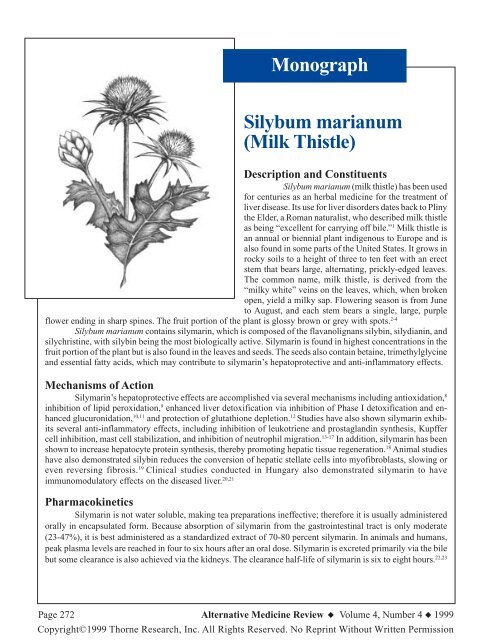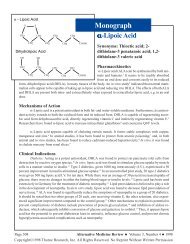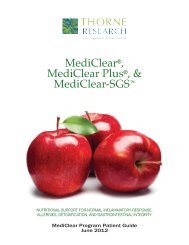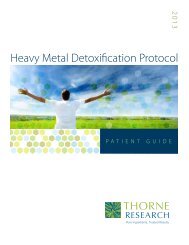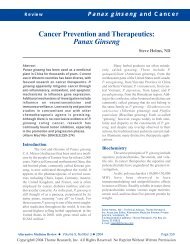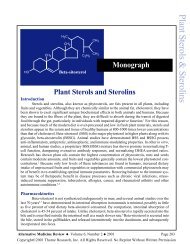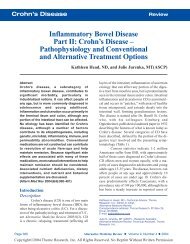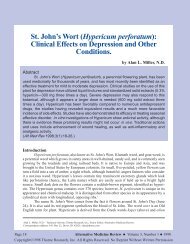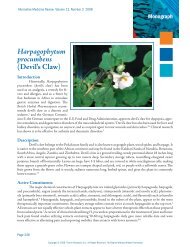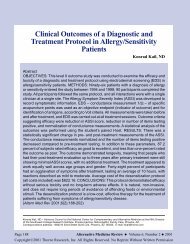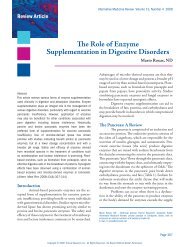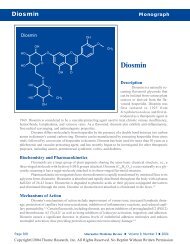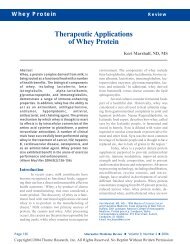Milk Thistle - Thorne Research
Milk Thistle - Thorne Research
Milk Thistle - Thorne Research
You also want an ePaper? Increase the reach of your titles
YUMPU automatically turns print PDFs into web optimized ePapers that Google loves.
Monograph<br />
Silybum marianum<br />
(<strong>Milk</strong> <strong>Thistle</strong>)<br />
Description and Constituents<br />
Silybum marianum (milk thistle) has been used<br />
for centuries as an herbal medicine for the treatment of<br />
liver disease. Its use for liver disorders dates back to Pliny<br />
the Elder, a Roman naturalist, who described milk thistle<br />
as being “excellent for carrying off bile.” 1 <strong>Milk</strong> thistle is<br />
an annual or biennial plant indigenous to Europe and is<br />
also found in some parts of the United States. It grows in<br />
rocky soils to a height of three to ten feet with an erect<br />
stem that bears large, alternating, prickly-edged leaves.<br />
The common name, milk thistle, is derived from the<br />
“milky white” veins on the leaves, which, when broken<br />
open, yield a milky sap. Flowering season is from June<br />
to August, and each stem bears a single, large, purple<br />
flower ending in sharp spines. The fruit portion of the plant is glossy brown or grey with spots. 2-4<br />
Silybum marianum contains silymarin, which is composed of the flavanolignans silybin, silydianin, and<br />
silychristine, with silybin being the most biologically active. Silymarin is found in highest concentrations in the<br />
fruit portion of the plant but is also found in the leaves and seeds. The seeds also contain betaine, trimethylglycine<br />
and essential fatty acids, which may contribute to silymarin’s hepatoprotective and anti-inflammatory effects.<br />
Mechanisms of Action<br />
Silymarin’s hepatoprotective effects are accomplished via several mechanisms including antioxidation, 8<br />
inhibition of lipid peroxidation, 9 enhanced liver detoxification via inhibition of Phase I detoxification and enhanced<br />
glucuronidation, 10,11 and protection of glutathione depletion. 12 Studies have also shown silymarin exhibits<br />
several anti-inflammatory effects, including inhibition of leukotriene and prostaglandin synthesis, Kupffer<br />
cell inhibition, mast cell stabilization, and inhibition of neutrophil migration. 13-17 In addition, silymarin has been<br />
shown to increase hepatocyte protein synthesis, thereby promoting hepatic tissue regeneration. 18 Animal studies<br />
have also demonstrated silybin reduces the conversion of hepatic stellate cells into myofibroblasts, slowing or<br />
even reversing fibrosis. 19 Clinical studies conducted in Hungary also demonstrated silymarin to have<br />
immunomodulatory effects on the diseased liver. 20,21<br />
Pharmacokinetics<br />
Silymarin is not water soluble, making tea preparations ineffective; therefore it is usually administered<br />
orally in encapsulated form. Because absorption of silymarin from the gastrointestinal tract is only moderate<br />
(23-47%), it is best administered as a standardized extract of 70-80 percent silymarin. In animals and humans,<br />
peak plasma levels are reached in four to six hours after an oral dose. Silymarin is excreted primarily via the bile<br />
but some clearance is also achieved via the kidneys. The clearance half-life of silymarin is six to eight hours. 22,23<br />
Page 272 Alternative Medicine Review ◆ Volume 4, Number 4 ◆ 1999<br />
Copyright©1999 <strong>Thorne</strong> <strong>Research</strong>, Inc. All Rights Reserved. No Reprint Without Written Permission
Silybum marianum<br />
Clinical Indications<br />
Amanita Mushroom Poisoning<br />
The most impressive use of silymarin is in the treatment of Amanita phalloides mushroom poisoning.<br />
The genus Amanita is widespread in Europe and North America with several edible species being prized by<br />
mushroom collectors. Unfortunately, many of the Amanita species are highly toxic, and ingestion results in<br />
severe liver damage and death in approximately 30 percent of cases. 24 In animal studies, silymarin given within<br />
10 minutes after amanita toxin ingestion completely counteracted the toxic effects, and if given within 24 hours<br />
of toxin ingestion silymarin prevented death and greatly reduced liver damage. 25<br />
Hepatitis<br />
Studies have shown silymarin to be effective in the treatment of both acute and chronic hepatitis. In<br />
acute viral hepatitis, administration of silymarin shortened treatment time and lowered serum bilirubin, AST,<br />
and ALT. In patients with chronic hepatitis, 420 mg silymarin per day for six months also yielded improved<br />
serum liver enzymes. 26<br />
Alcoholic Liver Disease and Cirrhosis<br />
Studies conducted in Austria and Hungary have demonstrated silymarin administration resulted in a<br />
normalization of serum liver enzyme and total bilirubin levels in patients with alcoholic liver disease, in addition<br />
to improved liver tissue histology. 27 In patients with cirrhosis, long-term (41 months) administration of silymarin<br />
at 420 mg per day resulted in a significant increase in survival compared to the placebo group. 28<br />
Hypercholesterolemia<br />
An animal study found silymarin given to rats with diet-induced hypercholesterolemia demonstrated an<br />
anticholesterolemic effect similar to probucol, with an increase in HDL cholesterol and a decrease in total and<br />
biliary cholesterol. 29<br />
Psoriasis<br />
The value of silymarin in the treatment of psoriasis may be due to its ability to improve endotoxin<br />
removal by the liver, inhibit cAMP phosphodiesterase, and inhibit leukotriene synthesis. Abnormally high levels<br />
of cAMP and leukotrienes have been observed in patients with psoriasis and normalization of these levels may<br />
improve the condition. 13,30<br />
Dosage/Toxicity<br />
Silybum marianum is usually given as a standardized extract (70-80% silymarin) in encapsulated form,<br />
100-300 mg three times daily being the typical adult dose. Both animal and human studies have shown silymarin<br />
to be non-toxic. At high doses (>1500 mg per day) a laxative effect is possible due to increased bile secretion<br />
and flow. Mild allergic reactions have also been noted but were not serious.<br />
References<br />
1. Pliny the Elder, Historia Naturalis 77 A.D.<br />
2. Bisset N. Herbal Drugs and Pharmaceuticals. London: CRC Press; 1994:121-123.<br />
3. Gruenwald J, Brendler T, Jaenicke C. PDR for Herbal Medicines. Montvale, NJ: Medical Economics Company, Inc.; 1998:1138-1141.<br />
4. Luper S. A review of plants used in the treatment of liver disease: part 1. Altern Med Rev 1998;4:410-421.<br />
5. Wagner H. Antihepatotoxic flavonoids. In: Cody V, Middleton E, and Harbourne JB eds. Plant Flavonoids in Biology and<br />
Medicine: Biochemical, Pharmacological, and Structure-Activity Relationships. New York, NY: Alan R. Liss, Inc.; 1986:545-558.<br />
Alternative Medicine Review ◆ Volume 4, Number 4 ◆ 1999 Page 273<br />
Copyright©1999 <strong>Thorne</strong> <strong>Research</strong>, Inc. All Rights Reserved. No Reprint Without Written Permission
6. Adzet T. Polyphenolic compounds with biological and pharmacological activity. Herbs Spices Medicinal Plants 1986;1:167-184.<br />
7. Hikino H, Kiso Y, Wagner H, Feibig M. Antihepatotoxic actions of flavonolignans from Silybum marianum fruits. Planta<br />
Medica 1984;50:248-250.<br />
8. Wagner H. Plant constituents with antihepatotoxic activity. In: Beal JL, Reinhard E eds. Natural Products as Medicinal Agents.<br />
Stuttgart: Hippokrates-Verlag; 1981.<br />
9. Bosisio E, Benelli C, Pirola O, et al. Effect of the flavanolignans of Silybum marianum L. on lipid peroxidation in rat liver<br />
microsomes and freshly isolated hepatocytes. Pharmacol Res 1992;25:147-154.<br />
10. Baer-Dubowska W, Szaefer H, Drajka-Kuzniak V. Inhibition of murine hepatic cytochrome P450 activities by natural and<br />
synthetic phenolic compounds. Xenobiotica 1998;28:735-743.<br />
11. Halim AB, el-Ahmady O, Hassab-Allah S, et al. Biochemical effect of antioxidants on lipids and liver function in experimentally-induced<br />
liver damage. Ann Clin Biochem 1997;34:656-663.<br />
12. Campos R, Garido A, Guerra R, et al. Silybin dihemisuccinate protects against glutathione depletion and lipid peroxidation<br />
induced by acetaminophen on rat liver. Planta Med 1989;55:417-419.<br />
13. Fiebrich F, Koch H. Silymarin, an inhibitor of lipoxygenase. Experentia 1979;35:150-152.<br />
14. Dehmlow C, Erhard J, de Groot H. Inhibition of Kupffer cell functions as an explanation for the hepatoprotective properties of<br />
silibinin. Hepatology 1996;23:749-754.<br />
15. Fantozzi R, Brunelleschi S, Rubino A, et al. FMLP-activated neutrophils evoke histamine release from mast cells. Agents<br />
Actions 1986;18:155-158.<br />
16. Dehmlow C, Murawski N, de Groot H, et al. Scavenging of reactive oxygen species and inhibition of arachidonic acid<br />
metabolism by silibinin in human cells. Life Sci 1996;58:1591-1600.<br />
17. De La Puerta R, Martinez E, Bravo L. Effect of silymarin on different acute inflammation models and on leukocyte migration.<br />
J Pharm Pharmacol 1996;48:968-970.<br />
18. Sonnenbichler J, Zetl I. Biochemical effects of the flavanolignane silibinin on RNA, protein and DNA synthesis in rat livers.<br />
In: Cody V, Middleton E, Harbourne JB, eds. Plant Flavonoids in Biology and Medicine: Biochemical, Pharmacological, and<br />
Structure-Activity Relationships. New York, NY; 1986:319-331.<br />
19. Fuchs EC, Weyhenmeyer R, Weiner OH, et al. Effects of silibinin and of a synthetic analogue on isolated rat hepatic stellate<br />
cells and myofibroblasts. Arzneimittelforschung 1997;26:643-649.<br />
20. Deak G, Muzes G, Lang I. Immunomodulator effect of silymarin therapy in chronic alcoholic liver diseases. Orv Hetil<br />
1990:131:1291-1292, 1295-1296. [Article in Hungarian]<br />
21. Lang I, Nekam K, Gonzalez-Cabello R. Hepatoprotective and immunological effects of antioxidant drugs. Tokai J Exp Clin<br />
Med 1990;15:123-127.<br />
22. Schandalik R, Gatti G, Perucca E, et al. Pharmacokinetics of silybin in bile following administration of silipide and silymarin<br />
in cholecystectomy patients. Arzneimittelforschung 1992;42:964-968.<br />
23. Tyler V. Herbalgram 1994;30:24-30.<br />
24. Vogel G, Tuchweber B, Trost W. Protection by silibinin against Amanita phalloides intoxication in beagles. Toxicol Appl<br />
Pharmacol 1984;73:355-362.<br />
25. Desplaces A, Choppin J, Vogel G, Trost W. The effects of silymarin on experimental phalloidine poisoning.<br />
Arzneimittelforschung 1975;25:89-96.<br />
26. Magliulo E, Gagliardi B, Fiori GP. Results of a double blind study on the effect of silymarin in the treatment of acute viral<br />
hepatitis, carried out at two medical centres. Med Klin 1978;73:1060-1065. [Article in German]<br />
27. Feher I, Deak G, Muzes G. Liver protective action of silymarin therapy in chronic alcoholic liver diseases. Orv Hetil<br />
1989;130:2723-2727. [Article in Hungarian]<br />
28. Ferenci P, Dragosics B, Dittrich H, et al. Randomized controlled trial of silymarin treatment in patients with cirrhosis of the<br />
liver. J Hepatol 1989;9:105-113.<br />
29. Kreeman V, Skottova N, Walterova D, et al. Silymarin inhibits the development of diet-induced hypercholesterolemia in rats.<br />
Planta Med 1998;64:138-142.<br />
30. Kock HP, Bachner J, Loffler E. Silymarin: Potent inhibitor of cyclic AMP phosphodiesterase. Meth Find Expel Clin Pharmacol<br />
1985;7:409-413.<br />
Page 274 Alternative Medicine Review ◆ Volume 4, Number 4 ◆ 1999<br />
Copyright©1999 <strong>Thorne</strong> <strong>Research</strong>, Inc. All Rights Reserved. No Reprint Without Written Permission


